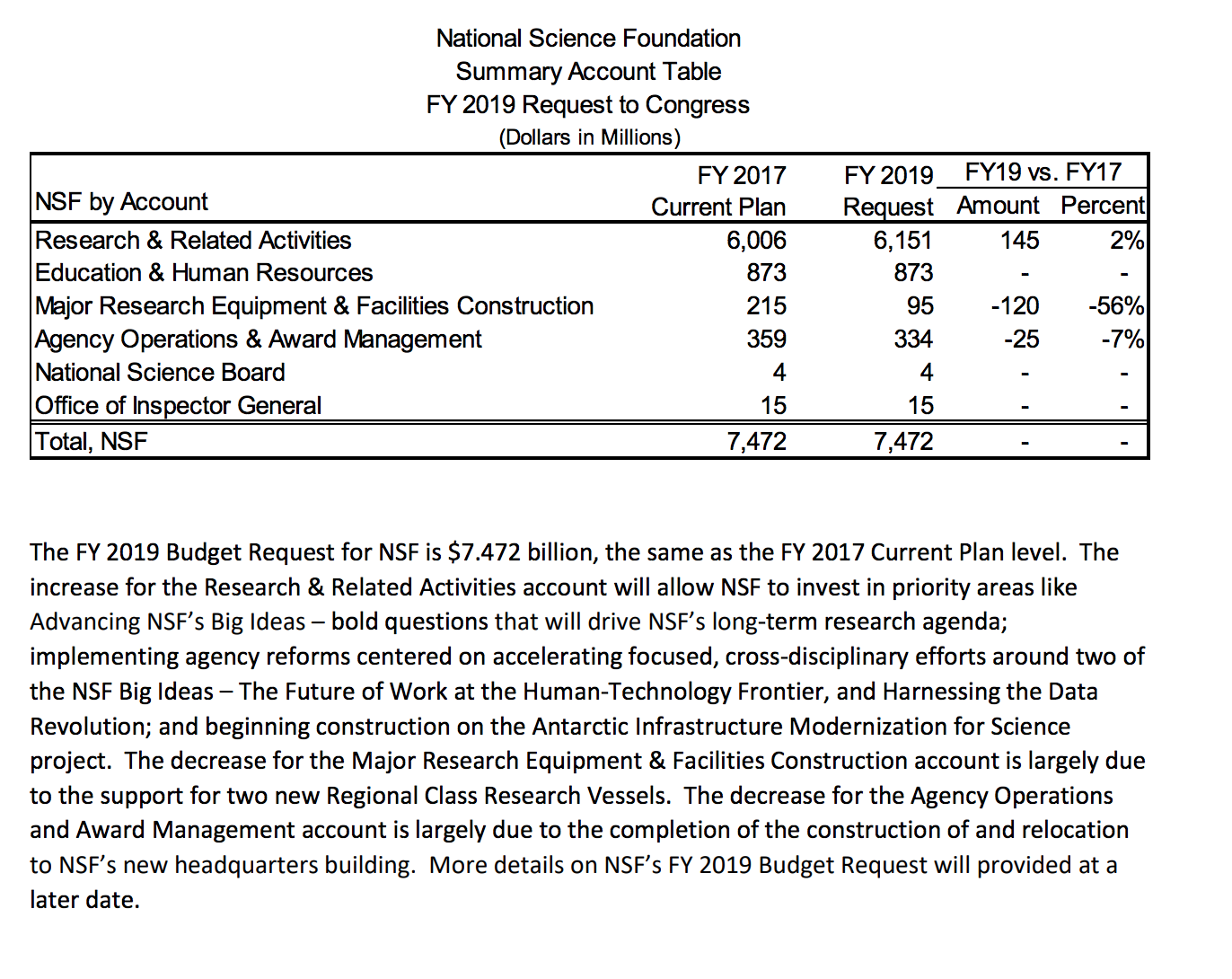President’s Budget Request a Mixed Bag for Science, but it Could Have Been Much Worse
What a difference a budget deal makes…
The President’s budget request for FY 2019, released yesterday, includes some modest gains and some big losses for Federal science agencies — details below, but on the whole a rather mixed bag for those who believe in the importance of the Federal investment in fundamental research. But it could have been much worse.
We’d gotten warning that the budget would likely slash science investments at multiple agencies in fairly dramatic ways. But that was before Congress and the Administration managed to agree late last week — with only a brief government shutdown — on a two year budget deal that increased budget caps on both defense and non-defense discretionary spending. That agreement, reached early Friday morning, boosted the non-defense discretionary spending cap by 26 percent over the next two years, and sent the White House’s Office of Management and Budget back to the drawing board over the weekend, revamping the President’s planned request to reflect the new fiscal reality.
And that’s a good thing, because the President’s planned budget for science was abysmal. We know some of the details about that original plan because the Administration didn’t have time to revamp some of the supporting documentation they’ve traditionally produced to accompany the budget request. An Analytical Perspectives volume is traditionally included with the budget submission and it includes budget breakdowns by theme, including a whole chapter on Research and Development. In that chapter you’ll find descriptions of the President’s priorities for Federal R&D, including “Protecting the Homeland from Physical and Cyber Attacks,” “Harnessing Artificial Intelligence and High Performance Computing,” and “Integrating Autonomous and Unmanned Vehicles into the Transportation Network,” but also several charts that detail what the Administration is requesting for each of the agencies involved in R&D work. Depressingly, most of the charts detail requests with double-digit percentage decreases for Federal science programs. For the National Science Foundation, for example, the only Federal agency whose mission includes support for all the fundamental science and engineering disciplines, here’s what the Administration planned to request for FY 2019:
[The column headings are: 2017 Actual; 2018 Annualized CR; 2019 Proposed; Dollar Change 2018 v 2019; Percent Change 2018 v 2019. So the deltas in the last two columns are compared to a FY18 budget that assumes flat funding from a continuing resolution.]
But the budget agreement changed most of that. With new caps that made room for $132 billion in additional non-defense spending, President Trump and his OMB Director Mick Mulvaney made the decision to add just $75 billion back to the non-defense budget. In his transmittal letter to Congress, Mulvaney acknowledged that though the President agreed to the new budget caps by signing them into law, he didn’t believe that the increases were completely justified for non-defense spending, so his request effectively leaves $57 billion in potential spending on the table.
Fortunately for the computing research community, NSF — which funds about 82 percent of all fundamental computing research in U.S. universities — was one of the agencies that benefitted from this last minute revamp. The President’s request calls for flat funding for the agency overall, but a 2 percent increase for NSF’s research accounts — a marked improvement over the 29 percent decrease originally considered before the budget deal. The last-minute revamp of the NSF budget means we don’t have much detail about how the agency would plan to spend the 2 percent windfall. In fact, here is the entirety of the agency’s budget justification (last year it was 470 pages):
 Other “winners” (loosely defined) among research agencies in the President’s budget include:
Other “winners” (loosely defined) among research agencies in the President’s budget include:
- Department of Defense Science and Technology: overall, up 2.3 percent over FY17; Basic Research (6.1) up 0.5 percent; Applied Research (6.2) down 4.4 percent; Advanced Technology Development (6.3) down 0.9 percent. DARPA is the big winner in DOD S&T with an increase of about 19 percent vs. FY17 in the President’s plan.
- National Institutes of Health: NIH was also slated for a substantial cut (27 percent) in Trump’s initial plans for FY 2019, but emerged from the weekend with a flat budget request vs. FY17.
- Department of Energy Office of Science: Slated to receive a 22 percent cut, instead would also get flat funding vs. FY17 in the President’s budget. Advanced Scientific Computing Research (ASCR) — primarily because exascale is a clear Administration priority, would see a 39 percent increase vs. FY17, growing to nearly $900 million.
But other agencies still find themselves subject to deep cuts in the President’s plan, even after the budget cap deal:
- Department of Energy’s Advanced Research Projects Agency (ARPA-E): The President’s plan once again eliminates funding for the ~$300 million agency. The President’s FY 2018 budget called for the program’s elimination, but congressional appropriators are split on whether to follow through. House appropriators agree with the President’s request to close the office, Senate appropriators included $330 million for the agency in their FY18 appropriation.
- National Institute of Standards and Technology: NIST’s Science and Technical Research and Services (STRS) would see a 16 percent reduction vs. FY17 under the President’s plan. NIST’s Manufacturing Extensions Partnership would be eliminated under the budget.
- Climate Research: The President’s budget would eliminate climate research programs at EPA, support only 3 of 8 USGS Climate Science Centers, and cancel five NASA earth science missions.
Of course, the President’s budget request is just the starting point in a year-long (or longer) process of appropriating funding for Federal agencies. Congress has the key role to play in actually putting numbers to these programs, and they’ve already demonstrated no serious commitment to budget suggestions from this Administration. Odds are also good that they’ll find ways to spend that extra $57 billion in non-defense spending the President didn’t see fit to include in his request.
There are also many other details about this budget we’re still waiting to learn — how NSF plans to prioritize its research, what shifts in cyber security research funding at the Department of Homeland Security mean for the character of the work supported, how the Department of Energy expects to ramp up exascale funding…to name just a few. And, of course, we still don’t know how congressional appropriators plan to put that extra spending towards the unfinished FY 2018 appropriations, something they need to decide before March 23rd, when the current continuing resolution funding government expires.
So while this is an important first step in science funding for FY19, it’s just the start of a long process. It would have been better to find more support from the President for the investments that help fuel the innovation that drives the nation’s economy and our competitiveness, but this is just the first word in the conversation and not the last. We’ll continue to weigh in with policymakers about the importance of the Federal investment in research. And we’ll track it all and report what we learn here, so stay tuned!











